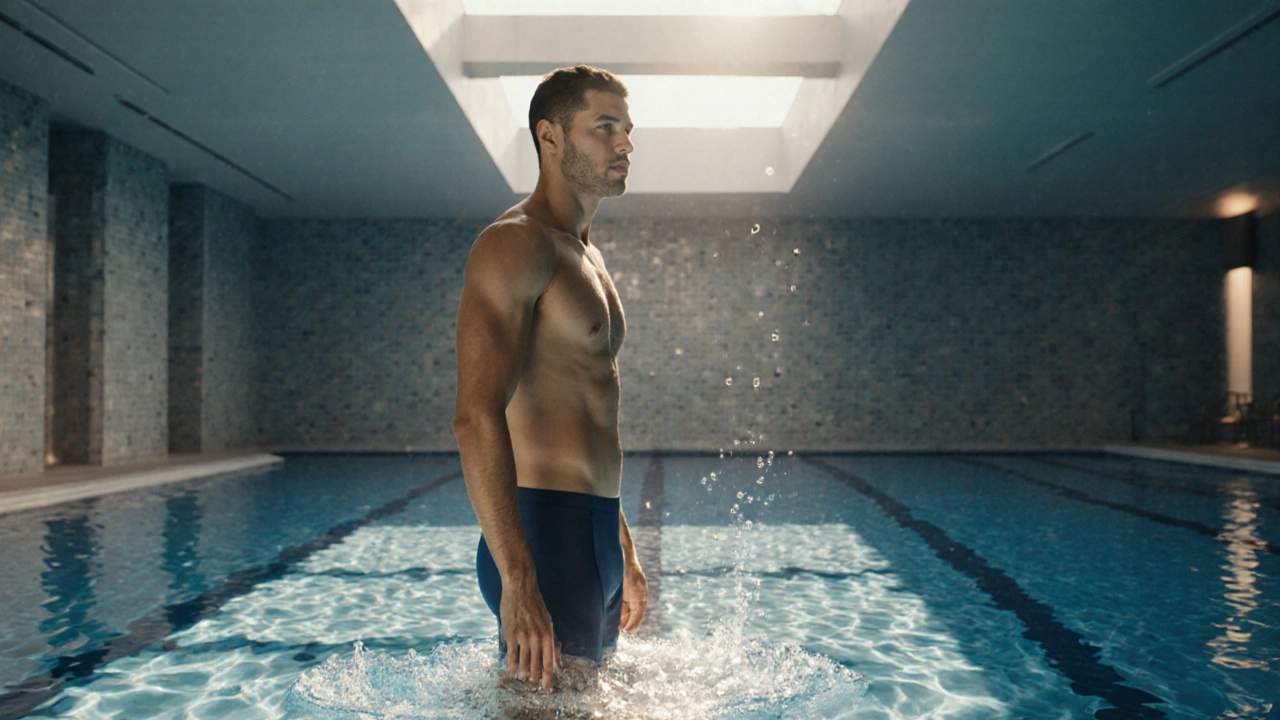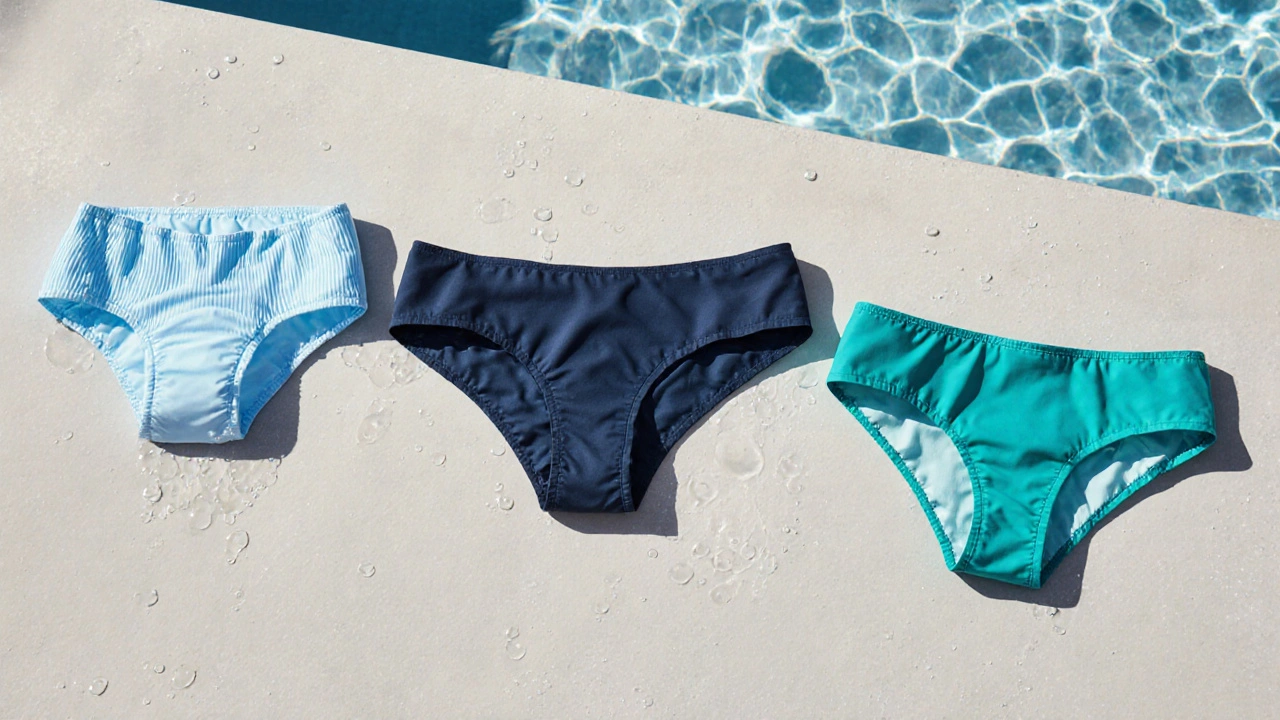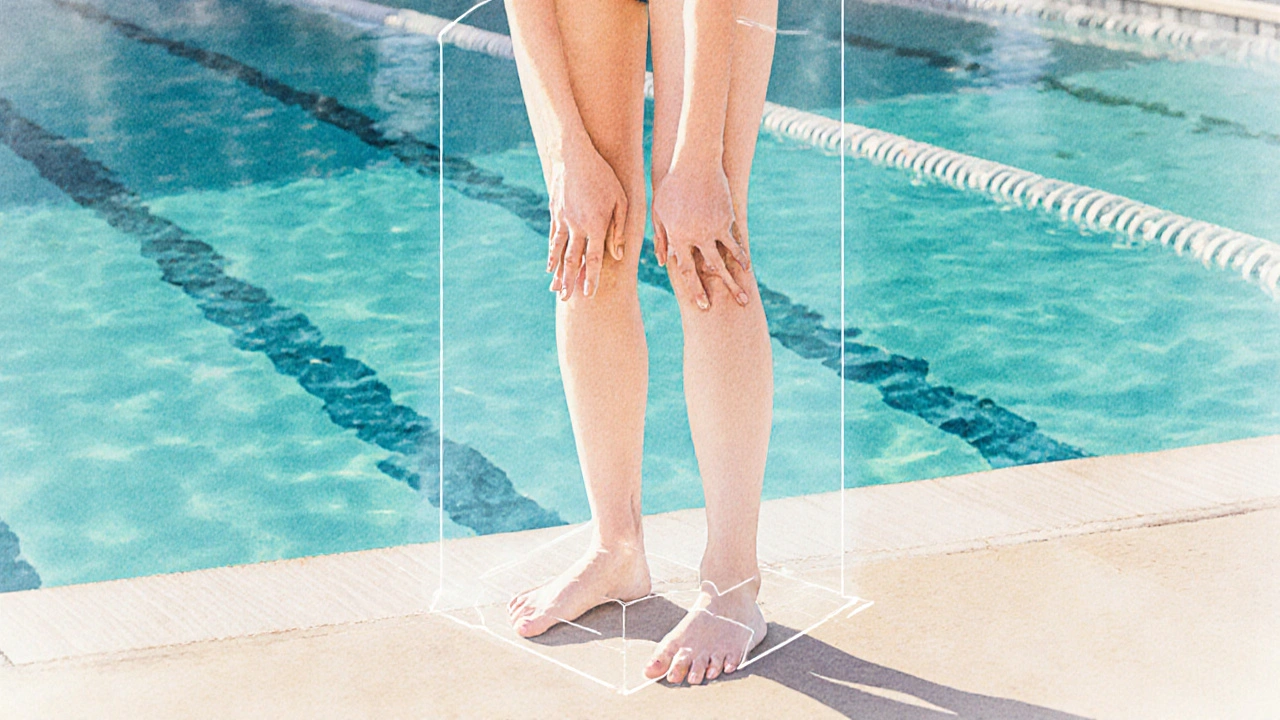
Swim Leak Prevention Guide
Your Recommended Product
Why this choice?
Swim Diaper
Best for short-term use and open-water events
30-50 mlWaterproof Underwear
Great for regular training and competitive swimming
60-80 mlAbsorbent Swimwear
Ideal for long-duration activities
40-70 mlEven the most confident swimmers can feel a flash of embarrassment when a sudden leak breaks the surface tension. It’s not just a personal nuisance - it can affect training, confidence, and even health if ignored. Below you’ll learn why leaks happen in the pool, practical ways to keep them under control, and when a professional opinion is worth the splash.
Key Takeaways
- Water pressure, temperature shifts, and muscle fatigue often trigger leaks during swimming.
- Choosing the right swim‑specific product (diaper, waterproof underwear, or absorbent swimwear) can dramatically reduce accidents.
- Targeted pelvic floor exercises and bladder‑training habits improve long‑term control.
- Persistent or painful leakage warrants a visit to a urology specialist for assessment.
Why Leakage Happens More Often in the Pool
When you submerge, two physical forces work against your bladder:
- Hydrostatic pressure - the water pushes against your abdomen, increasing intra‑abdominal pressure and nudging urine toward the urethra.
- Cold‑induced detrusor activity - colder water can cause the bladder muscle (detrusor) to contract involuntarily, especially in people with overactive bladder symptoms.
Combine these with the rhythmic core engagement required for swimming strokes, and the pelvic floor muscles can tire quickly. Fatigued muscles provide less support, making leaks more likely.
Immediate Management Strategies
Before you reach for a product, try these on‑the‑spot tactics:
- Pre‑swim bathroom break: Empty your bladder fully 5‑10 minutes before getting in the water. This reduces the volume that can leak.
- Adjust breathing patterns: Exhale fully during the stroke’s recovery phase to lower abdominal pressure.
- Adopt a supportive swimming position: Keep your core engaged but avoid excessive V‑shape (breaststroke kick) that spikes pressure.
- Use a discreet barrier: A thin, water‑resistant liner (see next section) can catch tiny dribbles without affecting buoyancy.
Choosing the Right Swim‑Specific Solution
Not all swimwear is created equal. Below is a quick comparison of three mainstream options that actually work in the water.
| Product | Absorption Capacity (ml) | Water‑Resistance | Fit & Comfort | Typical Use Case |
|---|---|---|---|---|
| Swim diaper | 30‑50 | Highly water‑proof (polyethylene outer layer) | Loose fit, designed for toddlers but sized for adults | Short‑term pool visits, open‑water events |
| Water‑resistant incontinence underwear | 60‑80 | Silicone‑coated fabric, retains shape in chlorine | Snug, looks like regular swim trunks | Regular training sessions, competitive swimming |
| Absorbent swimwear (built‑in liner) | 40‑70 | Micro‑fiber liner sealed with waterproof backing | Integrated into one‑piece suits, minimal feel | Long‑duration activities like aqua‑fitness |
When choosing, consider the activity length, chlorine exposure, and personal comfort. For most adult swimmers, a waterproof underwear option offers the best balance of discretion and performance.

Boosting Pelvic Floor Strength for Water Confidence
Pelvic floor exercise-often called Kegels-is the cornerstone of long‑term leakage control. Here’s a swim‑friendly routine:
- Identify the muscles: Stop urine flow midway; those are the pelvic floor muscles.
- Isometric hold: While standing on the pool deck, squeeze and hold for 5 seconds, then relax for 5 seconds. Repeat 10 times.
- Dynamic squeeze: During each breaststroke pull, contract the muscles for the duration of the pull (about 2‑3 seconds), then release.
- Progressive load: Increase hold time by 2 seconds each week, aiming for 10‑second holds after a month.
Consistency matters more than intensity. A quick 5‑minute daily session builds a resilient core that stays supportive even when water pressure spikes.
Bladder‑Training Habits That Complement Swimming
Training your bladder to hold longer volumes reduces the urge to rush to the restroom mid‑session. Follow these simple steps:
- Timed voiding: Start with a 2‑hour interval, then gradually extend to 3‑4 hours over several weeks.
- Fluid timing: Drink the bulk of your hydration 60‑90 minutes before hitting the water. Sip lightly during the session if needed.
- Avoid bladder irritants: Caffeine, carbonated drinks, and artificial sweeteners can trigger urgency.
Coupling timed voiding with pelvic floor work creates a double layer of protection.
When to Seek Professional Advice
If leaks persist despite the above measures, it’s time to consult a specialist. Urology specialist can assess:
- Underlying conditions such as urinary tract infections or bladder stones.
- Neurological factors that affect muscle control.
- Potential need for prescription‑strength medications (e.g., anticholinergics).
In many cases, a referral to a pelvic floor physiotherapist provides hands‑on biofeedback training, which accelerates muscle re‑education.
Practical Tips for Specific Water Settings
Public pools: Choose a product that can be rinsed quickly. Most facilities require swimmers to wear swimwear that doesn’t shed debris, so a waterproof underwear line passes inspection.
Open water (beach, lake): A swim diaper offers an extra layer of protection against sand or algae sticking to the fabric. Rinse with fresh water after exiting.
Aqua‑fitness classes: Opt for absorbent swimwear with a built‑in liner. The material dries fast and won’t interfere with resistance equipment.
Quick Checklist Before You Dive In
- Empty bladder fully 5‑10minutes prior.
- Wear a water‑resistant product suited to the activity.
- Warm‑up core muscles with light pelvic floor holds.
- Maintain steady, relaxed breathing throughout strokes.
- Carry a spare product if you plan a long session.

Frequently Asked Questions
Can chlorine damage swim diapers or waterproof underwear?
High‑quality swim diapers use a polyethylene outer layer that resists chlorine degradation for many sessions. Waterproof underwear with silicone coating may lose elasticity over time if exposed to strong chlorine daily, so rinse and air‑dry after each use.
Do pelvic floor exercises work for men who swim?
Yes. Men have a pelvic floor that supports bladder control. Regular Kegel‑style squeezes improve urethral closure strength and reduce post‑void dribbling during vigorous swims.
Is it safe to wear a regular pair of briefs under a swimsuit?
Regular cotton briefs retain water, become heavy, and can irritate the skin. They also don’t provide any barrier for leaks. Opt for a product specifically designed for water.
How often should I replace my swim‑specific incontinence product?
Inspect the product after each use. Visible thinning, loss of waterproof coating, or lingering odor means it’s time for a new one. For most brands, a lifespan of 30‑40 swims is typical.
Can certain foods worsen leaks during swimming?
Spicy foods, caffeine, and carbonated drinks can irritate the bladder and heighten urgency. Reducing these before a session can lower the risk of sudden leaks.
Managing urine leakage swimming isn’t about hiding a problem-it’s about equipping yourself with the right tools, habits, and knowledge so you can enjoy the water without constant worry. With the right product, targeted exercises, and professional guidance when needed, you’ll stay confident from the shallow end to the deep‑water lane.

 Health and Wellness
Health and Wellness
jenni williams
October 5, 2025 AT 03:11i totally feel ya 😂 ur not alone when that surprise splash happens, just remember a quick bathroom stop 5‑10 mins before you dive can cut a lot of the anxiety. a thin water‑resistant liner is also super discreet and won’t mess with your buoyancy, so you can keep focus on your strokes instead of worrying about a drip. plus, a few simple pelvic floor squeezes while you’re on deck can boost the muscles that keep things sealed when you hit the water. stay chill, you got this! 😊
Kevin Galligan
October 6, 2025 AT 01:24yeah, because nothing screams “pro swimmer” like strapping on a toddler diaper and pretending it’s haute couture. just toss a waterproof pair of underwear on and you’ll look less like a circus act. 🙃
Dileep Jha
October 6, 2025 AT 23:38from an ergonomics and hydrostatic pressure perspective, the intermittent intra‑abdominal load modulation during the catch‑phase induces a transient detrusor excitability spike, which in turn precipitates micro‑urination events. integrating a silicone‑coated incontinence liner mitigates fluid translocation through its low‑permeability membrane, thereby preserving hydrodynamic equilibrium. therefore, a biomechanical synergy between core stabilization and barrier technology is paramount for optimal performance.
Navjot Ghotra
October 7, 2025 AT 21:51i guess that stuff works but i dont really care its just another product that costs money
Claus Rossler
October 8, 2025 AT 20:04It is a veritable truism within the aquatic community that the selection of an incontinence apparatus should not be predicated upon mere aesthetic considerations, but rather upon a rigorous analysis of absorbency indices, hydrostatic resilience, and ergonomic congruence with the swimmer’s stroke mechanics. Indeed, the convergence of these parameters delineates a hierarchy of functional efficacy that transcends the superficial charms of fashionable swimwear.
chris mattox
October 9, 2025 AT 18:18Hey folks, think of this as a rainbow of options! 🌈 A swim diaper is like a superhero cape for those quick dips, waterproof underwear feels like a trusty sidekick for regular training, and absorbent swimwear is the ultimate marathon runner of the lot. Pick what vibes with your routine and splash confidently!
Jackson Whicker
October 10, 2025 AT 16:31Let us not delude ourselves into believing that this is a trivial inconvenience; the very act of concealing bodily functions behind a flimsy barrier reflects a deeper societal denial of natural human processes. Only by confronting the stigma head‑on can we elevate both performance and personal dignity in the pool.
Audrin De Waal
October 11, 2025 AT 14:44Honestly, this whole “just wear a diaper” nonsense is what the global elite want you to think is the only solution-keep the masses silent and focused on shallow pools while they control the waters. Real freedom comes from rejecting that narrative and mastering your own body, not by buying into capitalist‑crafted hygiene gadgets.
parag mandle
October 12, 2025 AT 12:58Managing urine leakage while swimming is not merely a matter of convenience; it is a comprehensive strategy that intertwines physiology, equipment, and disciplined habits. First, understand that hydrostatic pressure in water compresses the abdomen and can involuntarily stimulate the detrusor muscle, especially when the core is fatigued from repetitive strokes. Second, pre‑swim bladder emptying should become a ritual, allowing five to ten minutes for the residual urine to settle and the pelvic floor to reset. Third, incorporate a set of targeted pelvic floor contractions on the deck: hold a squeeze for five seconds, relax for five, and repeat ten times before you even dip your toes. Fourth, choose the appropriate barrier-waterproof underwear provides a snug fit and adequate absorption for most training sessions, while a swim diaper offers superior water resistance for open‑water events. Fifth, acknowledge that temperature plays a role; colder pools tend to provoke overactive bladder responses, so a thorough warm‑up can mitigate this effect. Sixth, stay mindful of your breathing pattern; exhaling fully during the recovery phase reduces intra‑abdominal pressure spikes that otherwise push urine toward the urethra. Seventh, hydrate wisely: consume the bulk of your fluids 60–90 minutes prior, and keep sipping lightly during the workout to avoid sudden urges. Eighth, avoid bladder irritants such as caffeine and carbonated drinks at least a few hours before swimming. Ninth, if leaks persist despite these interventions, seek a urological evaluation to rule out underlying conditions like infections or neurological deficits. Tenth, consider periodic sessions with a pelvic‑floor physiotherapist who can provide biofeedback and refine your technique beyond the basic Kegel routine. Eleventh, maintain a simple log of your sessions, noting duration, temperature, and any leakage incidents to identify patterns over time. Twelfth, replace your swim‑specific incontinence product when the waterproof coating shows wear or an unpleasant odor, typically after 30–40 uses. Thirteenth, remember that confidence in the water is a byproduct of preparation; the more meticulously you address each variable, the less intrusive the leak becomes. Fourteenth, share your experiences with fellow swimmers; community support often uncovers practical tips that textbooks overlook. Finally, embrace the reality that occasional leaks are part of the human condition, and with the right toolkit you can stay focused on improving your strokes rather than fearing the next surprise splash.
Wade Developer
October 13, 2025 AT 11:11While your systematic approach is commendable, I would add that a comparative analysis of the seal integrity offered by silicone‑coated fabrics versus polyurethane laminates could further inform product selection, particularly for swimmers operating in high‑chlorine environments where material degradation is a concern.
Sandra Perkins
October 14, 2025 AT 09:24oh great another guide about pee in pools lol
rama andika
October 15, 2025 AT 07:38sure, because the secret cabal of pool manufacturers totally wants us to keep our bladders full so they can sell more “leak‑proof” gizmos-big surprise, right?
Kenny ANTOINE-EDOUARD
October 16, 2025 AT 05:51For anyone tracking progress, I recommend logging the exact volume of fluid intake before each session alongside the duration of the swim; this data can reveal personal thresholds and help fine‑tune both hydration and bathroom timing strategies.
Craig Jordan
October 17, 2025 AT 04:04It is profoundly perplexing that, despite the proliferation of scholarly literature on urinary continence, a substantial segment of the amateur swimming populace continues to navigate these waters with a naïve disregard for evidence‑based protocols. One must contend with the entrenched myth that “it won’t happen to me,” a sentiment that not only undermines personal performance but also perpetuates a culture of silence around a perfectly manageable physiological phenomenon. If we are to advance the collective competence of swimmers, it is incumbent upon us to disseminate rigorous, peer‑reviewed recommendations and to demand that coaches incorporate bladder‑control curricula alongside traditional stroke techniques. Only then can we eradicate the embarrassment that has, for far too long, lingered beneath the surface of our aquatic endeavors.
Jeff Quihuis-Bell
October 18, 2025 AT 02:18Exactly! Let’s take Craig’s point and turn it into action: schedule a quick 5‑minute pelvic‑floor warm‑up at the start of every practice, and make it as routine as checking your goggles. Trust me, once you feel the difference, you’ll wonder how you ever swam without it.